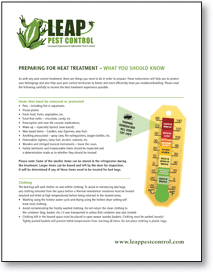PREPARING FOR HEAT TREATMENT – WHAT YOU SHOULD KNOW
Download a printable version
of our Thermal Heat Treatment
Preparation Sheet

As with any pest control treatment, there are things you need to do in order to prepare. These instructions will help you to protect your belongings and also help your pest control technician to better and more efficiently treat you residence/building. Please read the following carefully to receive the best treatment experience possible.
Items that must be removed or protected
- Pets – including fish in aquariums.
- House plants.
- Fresh food, fruits, vegetables, etc.
- Food that melts – chocolate, candy, etc.
- Prescription and over the counter medications.
- Make-up – especially lipstick (wax based).
- Wax based items – Candles, wax figurines, wax fruit.
- Anything pressurized – spray cans, fire extinguishers, oxygen bottles, etc.
- Flammables lighters, lamp fuel, alcohol, solvents, etc.
- Wooden and stringed musical instruments – leave the cases.
- Family heirlooms and irreplaceable items should be inspected and a determination made as to whether they should be treated.
Please note: Some of the smaller items can be stored in the refrigerator during the treatment. Larger items can be boxed and left by the door for inspection. It will be determined if any of these items need to be treated for bed bugs.
Clothing
The bed bug will seek shelter on and within clothing. To avoid re-introducing bed bugs, any clothing removed from the space before a thermal remediation treatment must be treated (washed and dried at high temperatures) before being returned to the treated areas.
- Washing using the hottest water cycle and drying using the hottest dryer setting will treat most clothing.
- Avoid contaminating the freshly washed clothing. Do not return the clean clothing to the container (bag, basket, etc.) it was transported in unless that container was also treated.
- Clothing left in the heated space must be placed in open weave laundry baskets. Clothing must be packed loosely!
- Tightly packed baskets will prevent lethal temperatures from reaching all items. Do not place clothing in plastic bags.
- Clothing in drawers can be left in place. Except if clothing is tightly packed, then some items must be removed.
Also, it may become necessary to remove the drawers from dressers to help with the air movement. - Clothing on hangers may be left in closets if the space between the items is large enough to allow the heated air to circulate. Arrange hanging items to open up air space between them.
Larger fabric items – linens, towels, blankets, etc.
These items should be left in the area being heated, as they are likely to shelter insects.
- Place these items in open weave laundry baskets. Pack the items very loosely to allow for air circulation. Do not pack into plastic bags.
Papers, smaller items, knick-knacks and collectibles
A thermal remediation treatment requires moving large amounts of air to be successful. All items that can be blown around and possibly damaged need to be protected.
- Loose papers need to be gathered and boxed.
- Glass items, knick-knacks and other collectibles will need to be secured. Do not leave breakable items on shelves or other areas where damage could happen.
- Pictures, paintings, and other wall-mounted items will need to be taken down to prevent damage.
Electronics, televisions, computers, video players, stereos, etc.
Electronics are a hiding place for bed bugs; do not remove electronics from areas being heated.
- Switch all electronic appliances to the off position.
- Disconnect all electronic appliances by unplugging from the wall outlet.
Water beds and air beds
- Water beds will need to be drained. If the water bed is not drained, it will prevent the frame from reaching lethal temperatures.
- Air beds will need to be partially deflated to avoid damage.
- Select comfort-style air beds with an electronic pump must be partially deflated and unplugged from the wall outlet.
